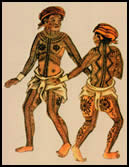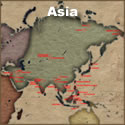The following is an excerpt from the Tattoo History Source Book:
The Philippines
Prince Giolo In September 1691, a fully tattooed South Sea Islander was brought to London
to be exhibited as a curiosity. He was a slave whose owner went to great lengths
to promote his public appearances by arranging to have two full-length portraits
engraved and published as illustrations for an elegantly printed pamphlet which
introduced him as "Giolo, the Famous Painted Prince". |
|
"He
was painted all down the breast, between his shoulders behind; on his thighs
before; and in the form of several broad rings, or bracelets, round his arms and
legs. I cannot liken the drawings to any figure of animals, or the like, but
they were very curious, full of great variety of lines, flourishes, checkered
work, etc. keeping a very graceful proportion, and appearing very artificial,
even to wonder, especially that upon and between his shoulder blades. By the
account he gave me of the manner of doing it, I understand that the painting was
done in the same manner, as the Jerusalem Cross is made in men's arms, by
pricking the skin, and rubbing in a pigment. But whereas (gun) powder is used in
making the Jerusalem Cross, they at Meangis use the gum of a tree beaten to a
powder called in English, Dammer, which is used instead of pitch in many parts
of India. He told me that most of the men and women of the island were thus
painted, and also that they all had ear rings made of gold, and gold shackles
about their legs and arms."
(William Dampier, Giolo, A New Voyage Round The World, 1697)
Giolo, didn't want to visit London, but was promised to be paid well for his
public appearances and told that he would be allowed to return home to his
native Philippines. Giolo became ill during the trip to England and soon died of
smallpox after his arrival.
Traditional Cordilleran Tattoo Practices in the Philippines
(Note the three paragraphs below are part of an excellent article by Lars
Krutak titled - Return of the Headhunters: The Philippine Tattoo Revival
The people of an ató (one of the political divisions of a Bontoc village)
could only tattoo when some person belonging to that ató had taken a head. In
1900, the people of Bontoc village maintained "that tattooing may not occur at
any other time, and that no person, unless a member of the successful ató, may
be tattooed." Tattooing instruments were made from a piece of wood or water
buffalo (carabao) horn about 10 cm long and 2 mm thick. At about a sixth of its
length it was bent at a right angle and, in the shorter arm, three to five
needles were affixed. The needles were laid on the skin and driven in with blows
of a wooden hammer at the rate of 90 to 120 taps per minute. Soot from resinous
wood such as spruce was used for pigment and rubbed into the wounds, causing the
flesh to rise in great welts, which sometimes became infected.
 Like the Kalinga, in every Bontoc village there was at least one man or woman
who was the tattooist (manbatek, Kalinga). One traveler noticed in May 1903 that
"there are two such in Bontoc - Toki, of Lowingan, and Finumti, of Longfoy - and
each has practiced his art on the other. Finumti has his back and legs tattooed,
and the designs were simple. A large double scallop extends from the hip to the
knee on the outside of each of Finumti's legs."
Like the Kalinga, in every Bontoc village there was at least one man or woman
who was the tattooist (manbatek, Kalinga). One traveler noticed in May 1903 that
"there are two such in Bontoc - Toki, of Lowingan, and Finumti, of Longfoy - and
each has practiced his art on the other. Finumti has his back and legs tattooed,
and the designs were simple. A large double scallop extends from the hip to the
knee on the outside of each of Finumti's legs."
Like other tribes in neighboring Borneo and New Guinea, Igorot tattooing was
considered a serious religious experience. The flowing blood attracted spirits (anito)
which could protect or destroy a community if the proper sacrifices were not
made. In the eyes of the people, all diseases, sicknesses or ailments, however
serious or slight, were believed to be caused by anito and sometimes these
malevolent spirits were not completely satisfied until they were offered a human
trophy head that would come to hang in the rafters of the ancestral ató.
Tattoo Museum Bibliography, Resources and Links
 See all Asian Tattoo Culture Articles here
See all Asian Tattoo Culture Articles here
More Resources:
Ancient tattooing explored
The Kalinga Batok (Tattoo) Festival
The Last Filipino Head Hunters
Tattooing: A vanished art among the I-Kalinga?
Pintados
Reviving Filipino Tattoo Traditions
NEXT >>
Polynesia
